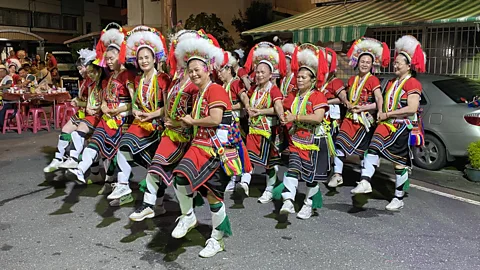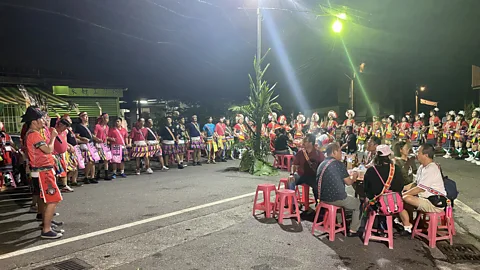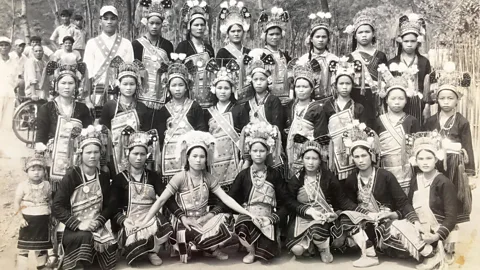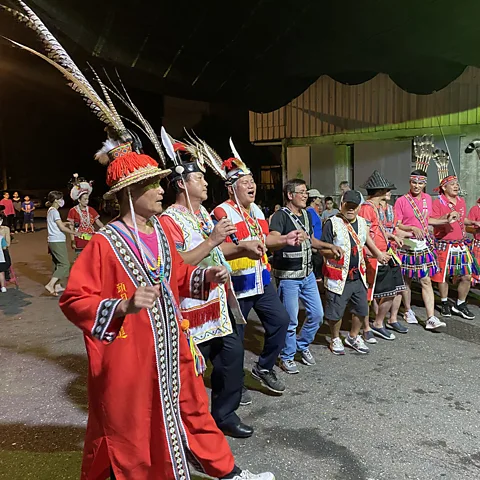By James RogersonFeatures correspondent

 James Rogerson
James RogersonOnce the island's only inhabitants, Indigenous Taiwanese now make up just 2.38% of Taiwan's population – and their vibrant festivals play a crucial part in preserving their culture.
Around 50 people holding hands in a line entered the small square in east Taiwan. At the head stood the chief dressed in a long red coat and a domed red hat. Beside him were eight older men in red-tasselled jackets followed by younger men in vibrant skirts and high-feathered headdresses. Next came the women who wore luminous plastic beads around their necks.
The line curled into a circle that slowly moved around the square as the dancers swung their connected hands and stamped one foot forward, then stepped back before thrusting the other foot out. The man next to the chief sang a short, powerful chant, with the line of performers responding in turn to each phrase. The combined effect was a hypnotic rhythm of repeated song and movement punctuated with yells or shrieks that continued for almost an hour. As I stood watching, I became increasingly transfixed.
I was at the Posko tribe's harvest festival celebration ("Ilisin" in Pangcah, the local language), which takes place every August in the town of Yuli in Taiwan's Hualien Province. The Posko are one of the many tribes of the Amis people, or Pangcah, as they like to be known – meaning "people" or "kinsmen". The Amis/Pangcah are the largest of Taiwan's Indigenous groups and mostly live in the counties east of Taiwan's central mountains: Hualien and Taitung and the Hengchun Peninsula.
Taiwan's Indigenous people – as opposed to the majority Chinese Han population – belong to the Austronesian group of peoples. Though they originated in Taiwan, many migrated to South East Asia, Micronesia and Polynesia from 1500 to 1000 BCE as a result of population growth. The Austronesians were great seafarers and developed sailing and navigation technologies that allowed them to travel long distances – Austronesian-speaking people today are the world's fifth-biggest language group with an estimated 400 million people.

 James Rogerson
James RogersonToday, however, Indigenous Taiwanese make up just 2.38% of the island's 23 million people. Of these, the Amis/Pangcah number roughly 200,000 and comprise 37.1% of the Indigenous population.
It is thought that Indigenous peoples (formerly known as Taiwanese aborigines) have inhabited Taiwan for more than 6,000 years; in fact, before 1620, there were only Indigenous peoples on the island. However, a succession of colonial powers invaded and ruled over the following four centuries: the Dutch and Spanish (1624-1668), the mainland Chinese Qing Dynasty (1683-1895), the Japanese (1895-1945) and finally The Republic of China (1945-1987).
During the 20th Century, Indigenous language and culture were eroded by policies of assimilation undertaken first by the Japanese and then by the KMT party who, under its leader Chiang Kai-Shek, governed Taiwan from 1949 to 1987, having moved The Republic of China to Taiwan in 1949 after being ousted from mainland China by Mao Zedong. Following Chiang's death in 1975, Taiwan began a transition to democracy and held its first elections in 1996, although China sees Taiwan as a breakaway province that will eventually be unified with the mainland.
Tibusungu 'e Vayayana, director of the Centre for Indigenous Research and Development at National Taiwan Normal University, explained the impact of KMT rule on the Indigenous population: "School education prohibited the use of Indigenous languages and excluded traditional knowledge and culture from the curriculum… leading to rapid language and cultural loss as well as confusion and even loss of cultural identity."

 Jasmine Wallace
Jasmine WallaceFor many Indigenous adults back then, it would have been a source of shame or embarrassment to use their traditional language in public. Likewise, for most of the 20th Century, they were referred to by the insulting term of "fan", meaning "barbarian", and it only became legal for people to use their Indigenous names on their identity cards in 1995. In fact, most Indigenous people today still use Chinese names.
More Indigenous festivals
In the Bunun tribe's Ear Shooting Festival each April and May, traditionally young men would hunt boar and deer in the mountains returning with an ear of their kill to be used as target practice by young, aspiring hunters. One of the larger celebrations is held in the village of Yongkang in the Yanping District in early May. The ceremony is open to outsiders and is said to be easy to find because the Bunun's songs can be heard from several kilometres away.
At the Flying Fish Festival, the Yami or Tao people celebrate the arrival of flying fish to Orchid Island off Taiwan's south eastern coast between January and June. Tourists are allowed to take part as long as they avoid certain taboos, including not catching and eating flying fish unless they appear on or above the water's surface, and not fishing with spear nets or drift nets. Anyone who breaks these rules is said to be cursed.
Thankfully, the harvest festival and other traditional rituals survived the cultural assimilation of the 20th Century, and the Ilisin are crucial in preserving the Pangcah's culture, as are other Indigenous ceremonies and weddings and funerals where traditional songs, dance and dress are still observed.
Earlier that day, I'd been invited by two sisters, Jasmine and Jennifer Tu, who live in Yuli and are from the Silangkong – another Pangcah tribe – to a banquet in the square that preceded the singing and dancing. There were dishes of spareribs and rattan stem (a palm grown in the hills above Yuli), steamed sea bass, and stir-fried wild boar and arrowhead bamboo. Bags of locally produced steamed glutinous rice were brought over to us. Glutinous rice plays an important part in Pangcah celebrations, including weddings and funerals, where it is used to make a sticky rice cake called "toron" that is a speciality of this region. The harvest festival is timed to celebrate the end of the rice harvest in July.
Jasmine and Jennifer explained the importance of the singing and chanting. Normally led by the chief or one of the elders, the chant is then echoed by the rest of the tribe. The main purpose is to show their gratitude to the spirits of their ancestors for protecting the community and praying for a good harvest the following year. The repeating of the chant demonstrates the tribe's respect for their elders and to emphasise the bond between tribal members. Each tribe has its own songs, and they are passed orally from generation to generation, sharing the stories of important figures and events from their past.

 James Rogerson
James RogersonThere is certainly something powerful and haunting about the Pangcah's singing. Many people might have heard it before: the German ambient pop group, Enigma, used a sample of an Amis chant on their 1994 single Return to Innocence, which then became an international hit and was used in a TV advert for the 1996 Olympics.
"It feels like a big family coming together," said Chen Yi, who was one of performers in the line, of the chanting. "It is about reminiscing about our ancestors and strengthening the will of tribal unity."
As the performance became more frenetic, people joined in the circular dance, including Jasmine and Jennifer, with their own colourful beads and bags. I was also pulled into the throng, everyone stomping their feet and swinging their arms as the chanting echoed around the square. I was struck by an intense feeling of euphoria as I was carried along in this collective moment of celebration.
I'd noticed that everyone in the original line was wearing a tasselled red satchel across their chests, and Jasmine later explained that it was known as a "lover's bag" and that "during the celebrations, girls or boys can put the bag on someone they like". The bags would often contain betel nuts as a gift, since Indigenous people chew them for their stimulant properties.
Traditionally it would be the girls who normally took the initiative of placing the bags – and this is how many couples would have got together in the past – but "it doesn't happen much now", Jasmine said.

 James Rogerson
James RogersonUntil the 20th Century, Pangcah society was a matriarchal one. Property was passed down through the female line and married couples would live with the wife's family. "For the husband it was an opportunity to improve the living conditions of his wife's family and was considered an honour," Jasmine said. However, the influence of Japanese and Han governance, where patriarchal family structures became the norm, changed this.
It is difficult to know what else of Pangcah culture has been lost because the Pangcah people have no written records of their history. Traditionally culture and traditions were passed from generation to generation through word of mouth. Sadly, few people still speak much of their original language and in many aspects of their lives – from language to food to education – Indigenous people have been assimilated into Taiwanese culture.
For Jasmine, this makes the festival all the more significant. "These celebrations are especially important to tribal people as our cultural identity and values are now weak," she said.
Sifo Lakaw, chairman of the Association of Pangcah Language Revitalization in Taiwan and an expert on Pangcah traditions, agrees. "The Ilisin is one of the only activities within the tribe where everyone is involved in the festival and its organisation," he later told me. "It is important because it encourages each household to appreciate each other and brings the community together."

 James Rogerson
James RogersonHowever, despite the damage caused to Taiwan's Indigenous culture, there are reasons to be optimistic for the future. Since the 1990s, Taiwan has been striving to be more inclusive. Legislation has been brought in to protect Indigenous rights, such as the Basic Law for Indigenous Peoples, which was enacted in 2005 and has led to what Vayayana described as "a greater judicial respect for Indigenous traditional customs, religion and land rights". More recently, in 2017, the Indigenous Language Development Act was passed allowing children to learn Amis in school.
Chen is hopeful about the future of the Posko: "Our ethnic ideology, culture, language, history and stories and clothing – these are all things that will be tested in the future, and we must focus on how to preserve and pass these on to the next generation," she said.
In the square, the festival was drawing to a close. A group of young men and women walked slowly from house to house singing a chant and banging big staffs made of bamboo on the ground. They were announcing that another annual festival had ended and were offering up prayers to the ancestors. As I watched, they marched slowly out of the square, the silhouettes of their headdresses distinct under the glow of the streetlights and songs echoing behind them, before disappearing into the dark.
---
Join more than three million BBC Travel fans by liking us on Facebook, or follow us on Twitter and Instagram.
If you liked this story, sign up for The Essential List newsletter – a handpicked selection of features, videos and can't-miss news delivered to your inbox every Friday.
"original" - Google News
January 26, 2024 at 08:00PM
https://ift.tt/z8l0e43
A vibrant celebration of Taiwan's little-known original inhabitants - BBC.com
"original" - Google News
https://ift.tt/s0zj1Ix
https://ift.tt/PwLxdQh
Bagikan Berita Ini














0 Response to "A vibrant celebration of Taiwan's little-known original inhabitants - BBC.com"
Post a Comment